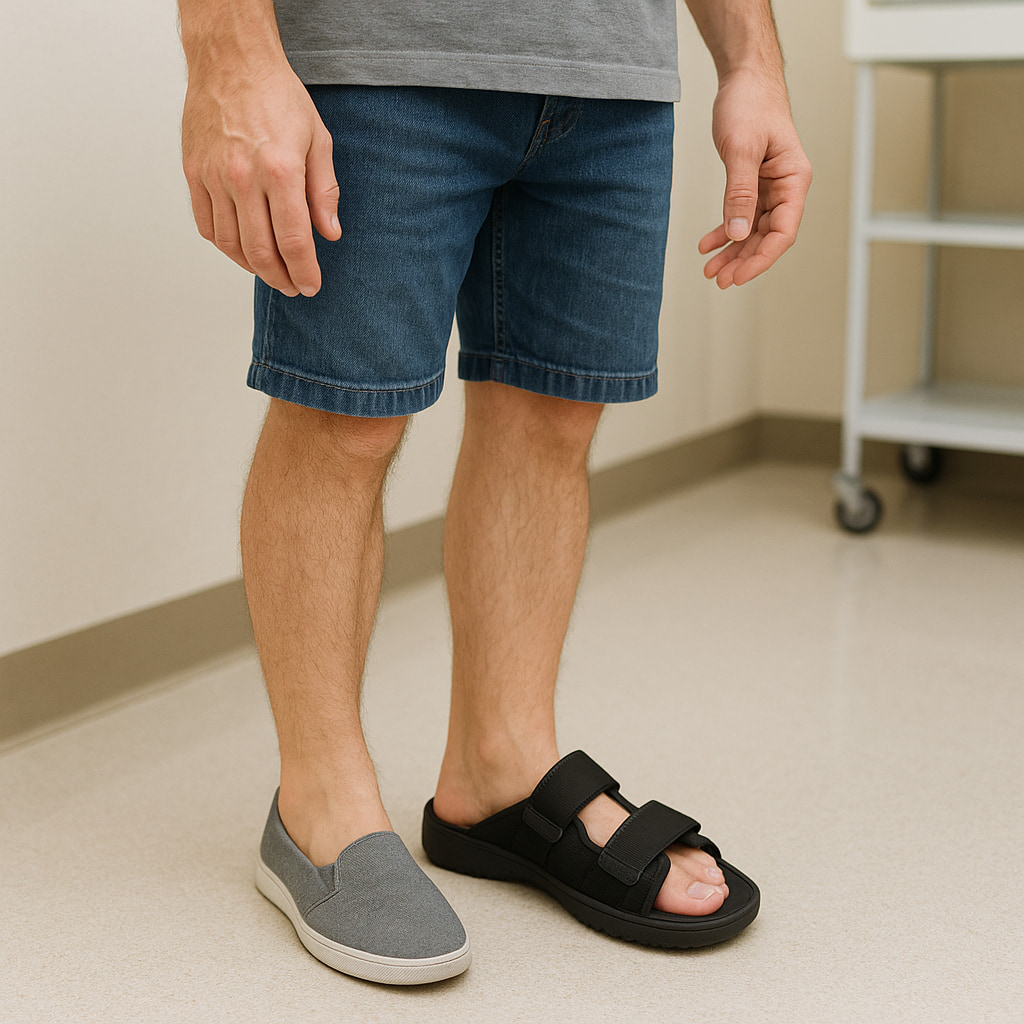See Also:
Rehabilitation Goals
- Protect the surgical site and promote optimal healing
- Reduce pain and swelling
- Restore range of motion (ROM) and strength
- Return to full functional activities
- Prevent recurrence or complications
Expected Recovery Time
| Milestone | Timeframe Range |
|---|---|
| Initial wound healing | 10–14 days |
| Start weight-bearing (partial) | 2–6 weeks |
| Full weight-bearing | 6–10 weeks |
| Return to normal footwear | 8–12 weeks |
| Return to low-impact activity | 10–14 weeks |
| Full return to activity/sport | 4–6 months |
Phase 1: Early Post-op (0–2 weeks)
Goals:
- Protect surgical site
- Minimize swelling and pain
- Initiate gentle movement
Instructions:
- Keep foot elevated above heart level as much as possible
- Use prescribed post-operative shoe or boot
- Ice regularly (15–20 minutes, 3–4x/day) using a cloth barrier
- Keep incision dry and clean
- No weight-bearing on the surgical foot unless instructed
Exercises:
- Ankle pumps (10–20 reps, every hour while awake)
- Toe wiggling (gently, if permitted)
- Isometric quadriceps and glute squeezes
Phase 2: Protected Mobilization (2–6 weeks)
Goals:
- Begin safe mobilization
- Continue to manage pain and swelling
- Start gentle toe movement
Instructions:
- Begin partial weight-bearing as advised, using crutches or walker
- Wear post-op boot or stiff-soled shoe at all times
- Continue icing and elevation as needed
- Monitor incision for signs of infection
Exercises:
- Continue ankle pumps and isometric exercises
- Begin gentle active range of motion (AROM) of the big toe (unless restricted)
- Seated towel curls and marble pickups (as tolerated)
Phase 3: Functional Recovery (6–10 weeks)
Goals:
- Transition to full weight-bearing
- Improve foot mobility and strength
- Begin gait training
Instructions:
- Transition out of boot into stiff-soled or wide-toe box shoes as tolerated
- Begin gentle stretching of calf and foot muscles
- Continue edema control techniques if swelling persists
Exercises:
- Toe flexion/extension stretches
- Intrinsic foot muscle strengthening (e.g., towel scrunches)
- Standing heel raises
- Seated balance work (e.g., sit-to-stand transitions)
Phase 4: Advanced Strengthening & Function (10–16 weeks)
Goals:
- Restore full strength and range of motion
- Normalize walking pattern
- Begin return to light activity
Instructions:
- Gradually increase activity duration and intensity
- Use proper footwear with good arch support and wide toe box
- Avoid high-impact activities
Exercises:
- Resistance band exercises for ankle and foot
- Standing balance and proprioception (e.g., single-leg stand)
- Step-ups and mini-squats
- Begin low-impact cardio (cycling, swimming, elliptical)
Phase 5: Return to Activity (4–6 months)
Goals:
- Safely resume full function and desired physical activity
- Maintain strength and flexibility
- Prevent re-injury
Instructions:
- Resume sports or high-impact activity only with clearance
- Continue home exercise program for long-term maintenance
- Monitor for signs of overuse or discomfort
Exercises:
- Sport-specific drills as appropriate
- Progressive loading exercises (e.g., hopping, jogging)
- Continued strengthening, balance, and mobility routines
When to Contact Your Surgeon
Contact your surgeon immediately if you experience:
- Increased redness, swelling, or drainage from the incision
- Fever over 38°C
- Persistent or worsening pain not relieved by medication
- Numbness, tingling, or discoloration in the foot
- Difficulty bearing weight beyond the expected timeframe
Disclaimer
This is a general guideline. Your physiotherapist or Dr Lambers may adjust the protocol based on your specific condition and progress.
